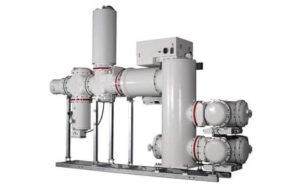As the demand for electricity continues to rise, power generation facilities must ensure a reliable supply while incorporating protective equipment to facilitate safe power transmission. Substations play a crucial role in the electrical generation, transmission, and distribution process by converting high-voltage electricity into lower voltages suitable for consumer use.
Substations come in two main types: Gas Insulated Switchgear (GIS) substations and Air Insulated Switchgear (AIS) substations. Each has unique characteristics that make it suitable for different applications. Below, we explore the differences between GIS and AIS substations in detail.
 Gas-insulated-Switchgear[/caption]
Gas-insulated-Switchgear[/caption]
A Gas Insulated Substation (GIS) is an advanced type of substation where electrical components are housed in a sealed metal enclosure filled with SF₆ gas (sulfur hexafluoride), which serves as the dielectric insulating medium. SF₆ is an excellent insulator with superior dielectric properties, making GIS a preferred choice for environments where space is limited or harsh weather conditions prevail.
✔ Compact design – Requires significantly less space than AIS systems.
✔ High reliability – Minimal exposure to environmental factors reduces maintenance needs.
✔ Enhanced safety – Fully enclosed components minimize risks such as arc flashes.
✔ Long service life – SF₆ gas has a lifespan of up to 40 years without degradation.
✔ Superior performance – Excellent insulation properties prevent voltage breakdowns.

An Air-Insulated Substation (AIS) relies on ambient air as the insulating medium for its electrical components. AIS has been widely used in power transmission systems for decades and remains the dominant technology globally, accounting for over 70% of all substations.
✔ Lower initial cost – More cost-effective compared to GIS installations.
✔ Easier maintenance – Equipment is exposed, making inspection and repairs straightforward.
✔ Faster construction – Can be set up quickly, particularly in areas with ample space.
✔ Ideal for rural locations – Best suited for open landscapes where space is not a constraint.
| Comparison Factor | GIS Substation | AIS Substation |
|---|---|---|
| Insulating Medium | SF₆ gas | Atmospheric air |
| Space Requirement | Compact, ideal for space-constrained areas | Requires more land |
| Cost | High initial investment | More affordable upfront |
| Maintenance | Low maintenance, but requires specialized personnel | Frequent maintenance but easier to service |
| Reliability | High reliability due to enclosed design | More exposed to environmental factors |
| Safety | Reduced risk of arc flashes and faults | Higher risk due to open components |
| Installation Time | Faster assembly | Longer construction period |
| Seismic Resilience | Better resistance to earthquakes due to compact design | More vulnerable to seismic activity |
| Environmental Impact | SF₆ gas leakage is a concern | No greenhouse gas emissions |
| Suitability | Ideal for urban areas, high-voltage applications, and extreme weather conditions | Best for rural locations with available space |
✔ Lower installation costs – More cost-effective than GIS.
✔ Easier maintenance – Faults can be identified and repaired quickly.
✔ Faster construction – Ideal for projects with time constraints.
✔ No greenhouse gas concerns – Unlike SF₆ gas in GIS, AIS does not contribute to global warming.
✘ Large footprint – Requires significant space, making it impractical in urban settings.
✘ Higher maintenance needs – More frequent inspections and servicing.
✘ Environmental exposure – Susceptible to pollution, weather conditions, and corrosion.
✘ Lower insulation efficiency – Air has a lower dielectric strength compared to SF₆ gas.
✔ Compact design – Takes up less space, ideal for urban environments.
✔ High reliability – Fully enclosed system prevents contamination and faults.
✔ Low maintenance – Requires minimal servicing compared to AIS.
✔ Enhanced safety – Reduced risk of arc flashes due to insulated components.
✔ Better performance in harsh climates – Works well in extreme temperatures and seismic zones.
✘ Higher initial cost – Requires a larger investment upfront.
✘ Complex maintenance – Requires specialized personnel and equipment.
✘ Potential SF₆ gas leakage – SF₆ is a potent greenhouse gas, requiring careful handling.
✘ Longer outage times – Faults in GIS can lead to prolonged downtimes.
Choosing between GIS and AIS substations depends on several factors, including budget, space availability, environmental considerations, and maintenance requirements.
By understanding these key differences, utilities and industries can make informed decisions when selecting the most suitable substation technology for their needs.